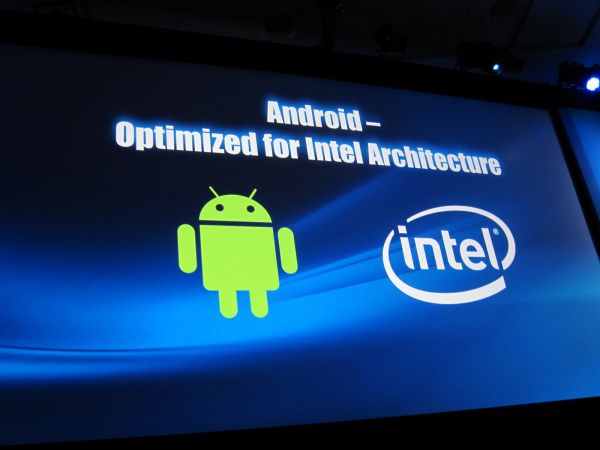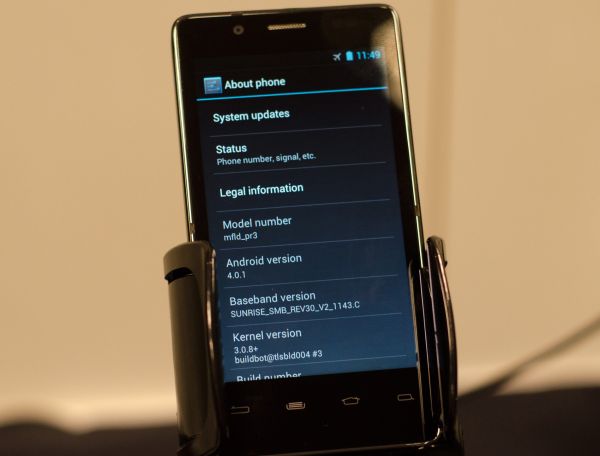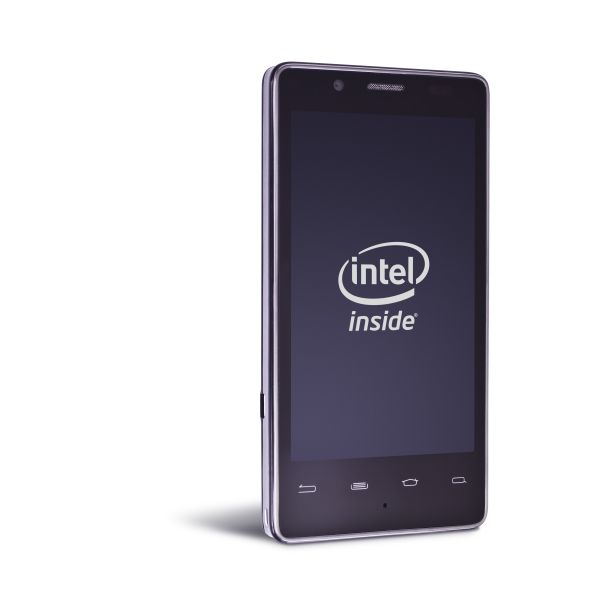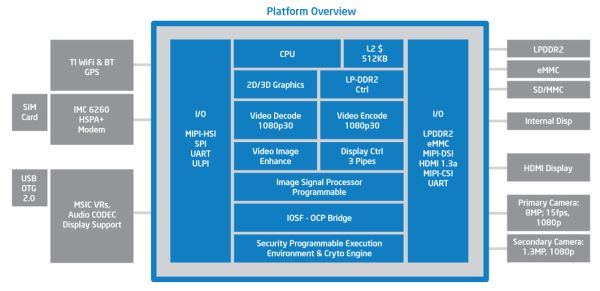Intel's Medfield & Atom Z2460 Arrive for Smartphones: It's Finally Here
by Anand Lal Shimpi on January 10, 2012 8:00 PM ESTWhat's Different This Time Around: Google & A Sweet Reference Platform
Intel has been talking about getting into smartphones for a couple of years now, but thus far it hasn't been able to secure a single design or partnership that that resulted in a product actually coming to market. This time around, things are different. The major change? Focus, and Google.
Intel originally had ambitions of enabling its own mobile OS with the help of Nokia (Moblin/MeeGo). Intel also wanted to support Android as well, however its attention was clearly more focused on the Moblin/MeeGo effort. Similar to the wake up call that pushed NVIDIA to focus exclusively on Android, Intel has now done the same.
At IDF last year Intel and Google announced a partnership and the intention to bring all future versions of Android, starting with Gingerbread, to x86. Since then Intel has ramped up the software engineering engine, going into the Android source code (Gingerbread, Honeycomb and now ICS) and fixing bugs. Intel's goal is to deliver the most stable version of Android as a result of its efforts. Intel is also submitting its changes upstream to the AOSP, which should help improve the Android experience even on ARM platforms.
Under the leadership of Mike Bell (formerly of Apple and Palm), Intel has also created an extremely polished Medfield reference design. This is the same design shown off at IDF last year (apparently there's an even thinner one floating around somewhere), but what separates it from other reference designs we've seen from SoC vendors is that the Medfield reference platform was designed to be a polished phone that could theoretically be rebranded and resold.
Intel knew the onus was on itself to prove that Medfield, Atom and even just x86 was power efficient enough to be delivered in a compelling form factor with competitive battery life. Paul Otellini gave Mike carte blanche access to any of Intel's resources. Instead of having to work with existing Intel groups, Mike was allowed to assemble his dream team of engineers. The team Mike built is what he felt he needed to not only bring Medfield to market, but also to build the a first class Atom based smartphone.
The result is this:
Internally it features Intel's own XMM 6260 HSPA+ modem. Intel claims LTE is on the way although there's no ETA on that.
WiFi in the reference design is provided by TI's 1283 controller. Intel's wireless team does not have a a WiFi solution that's low power enough to work in a smartphone, although after the recent restructuring the team has now been tasked with building an ultra low power solution that can.
The display is a somewhat unusual 1024 x 600 panel, with support for 1080p30 (and 1080i60) output via HDMI. The SoC specs are identical to what I've already discussed: 1.6GHz max CPU clock and a 400MHz GPU clock.
The reference platform is not only smartphone sized, but Intel has built its own qualification labs that mirror those of the carriers to ensure quality and convince its customers of the platform's legitimacy. In essence, Intel has built its own miniature smartphone design and test center.
The Medfield reference platform is available for use by any of Intel's customers, and indeed that's what's already happening. Lenovo's K800 is based on a modified version of Intel's reference platform, and I wouldn't be surprised if more aren't on the way.
All of this sounds a lot like Intel's efforts in the motherboard space over a decade ago where it started providing motherboard manufacturers with reference designs that they could modify if they desired. The effort helped significantly reduce time to market and allowed the motherboard makers to focus more on specializing on what they were good at.
The Medfield reference platform is designed to do the very same for smartphones. Intel wants to provide its partners with a well designed, stable smartphone platform. If they choose to use it, they can shave off a significant amount of development time and spend more of their time on software or simply bring a good reference phone to market in a quick fashion. I'm not entirely sure I've seen many players in the Android space that are actually all that great at software development, but Intel believes anything that shortens time to market will be appreciated.
I asked Intel if it has any plans to offer the reference platform unlocked, direct to customers. Unfortunately the answer at this point is still no. I suspect that Intel is more interested in building its customer base rather than circumventing it.
















164 Comments
View All Comments
BSMonitor - Wednesday, January 11, 2012 - link
Lot of "if's" and "shoulds" in your argument.Lucian Armasu - Wednesday, January 11, 2012 - link
Well, he's comparing Atom with ARM based on benchmarks that Intel has provided, and for a chip that won't be out until the end of the year. So that's not very realistic either. Intel has been saying for a long time that "this is finally the year we're going to compete with ARM". I'm very skeptical at this point, until I really see it in the market, in a real phone, and see how it does against the competition then.tipoo - Thursday, January 12, 2012 - link
Indeed, we'll have to wait and see. Also, since this chip is a single core its easier to get its full potential, on apps that are well threaded we might see even current ARM chips beat it.Donnie Darko - Wednesday, January 11, 2012 - link
I'm generally more excited to see x86 in the market because it will drive competition more than it will drive Intel into a new field.It was an impressive technology demo, but to be honest untill they can integrate the base band radio onto the SOC they won't compete. You will be able to buy their phones and that's nice, but Qualcom will still dominate the market with Sammy/Ti and even Nvidia (shudder) rounding out most of the other designs.
Having a top to bottom stack will be nice though for everyone. Arm laptops/tablets, file servers, massivly-wide simple-instruction servers and phones. x86 HP computing (Sever->Tablets) and phones. If Intel can make enough of a beac h head then we should see AMD in the mobile space in a couple of years two. Their synthesisable CPU cores with Bobcat and their GPUs would be wicked down there.
guilmon19 - Wednesday, January 11, 2012 - link
I usually like competition as well, but when intel jumps in there i (shudder). At the moment Samsung, Motorla, qualcom, texas, ect were competing with each other with their own SoC, but they had to use the same fab to build their CPU's, but intel has their own fab(that is alot better then the ones used to build ARM) so they get a huge advantage over all those companies.Griswold - Wednesday, January 11, 2012 - link
It's the answer to a question nobody asked!tipoo - Thursday, January 12, 2012 - link
And to the left of it! Its the comment that means no one but the original poster, if even that!pugster - Wednesday, January 11, 2012 - link
Frankly, I don't know how does Intel can do 1.6ghz cpu and 400mhz gpu for less power than an arm cpu. Gees, we have seen 1.6ghz atom cpus in netbooks and the power envelope is much higher and a 32nm process can't reduce this much further.Second, the phone's cpu is usually in deep sleep most of the time, intel didn't really benchmark what happens when the phone is idle, IE standby time.
Third, is cost. Unless Intel start selling these cpus at giveaway prices for less than $15, I doubt that these phones are competitive to ARM variants.
Fourth is adoption rate. Considering that most of the apps are written for the ARM cpus, I wonder when phone manufacturers and porogrammers will port intel version of their apps.
bobsmith1492 - Thursday, January 12, 2012 - link
The article covers power consumption and porting.Cost is a valid concern! Real-life use cycles will be good to show how quick it transitions into and out of sleep for real-life power use. Being faster when active with the same power use though it should be better if anything. The clock rate scaling will compete against the big-little architecture for ARM, too.
Roy2001 - Wednesday, January 11, 2012 - link
Very impressive. Good job Intel!